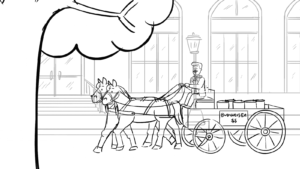Choosing the right type of animation for your business marketing—whether 2D or 3D—can significantly impact how your message is received and understood by your target audience. This choice hinges on several factors, including the nature of your message, audience preferences, and marketing goals. Here, we explore 2D vs. 3D animation to help you make an informed decision.
Understanding 2D Animation
2D animation involves creating movement in a two-dimensional space, offering a flat but visually appealing narrative style. It is often used for animated explainer videos due to its simplicity and ability to convey messages clearly and quickly. The style is characterized by its creative graphics and ability to portray motion without the need for complex visual depth—making it ideal for storytelling and conveying abstract ideas.
Advantages of 2D Animation:
- Cost-Effectiveness: 2D animation is often more affordable than 3D due to simpler software requirements and shorter production times. This makes it a viable option for businesses operating on a budget while still seeking quality animated content.
- Quicker Turnaround: The production cycle for 2D animation is typically shorter, which is particularly beneficial for marketing campaigns under tight deadlines. The speed is achieved because 2D animation does not require the complex modeling and rendering stages that 3D does.
- Artistic Flexibility: 2D animation brings extensive creative freedom, allowing animators to experiment with various artistic styles. The versatility makes it easier to produce unique visuals that can align closely with a brand’s aesthetic, enhancing brand identity through custom-tailored designs.
- Simplicity in Messaging: Because of its flat nature, 2D animation is excellent at delivering messages clearly and succinctly without the potential distractions of depth and volume that come with 3D animation. It can be particularly effective for educational content or explainer videos that aim to communicate ideas without unnecessary complexity.
- Broader Appeal: The classic look of 2D animation has a broad appeal, often evoking a sense of nostalgia and ease of reception among diverse audiences. This can make 2D animations particularly effective for brands looking to establish a connection with viewers through familiar visual styles.
Exploring 3D Animation
3D animation adds depth, making images appear more lifelike and realistic. This type is favored for animated training videos where detail and depth are crucial for understanding complex processes or for product demos where showcasing a product from multiple angles enhances the viewer’s comprehension.
Advantages of 3D Animation
Visual Impact:
- Engaging Content: 3D animation creates visually captivating scenes that can grab and hold the viewer’s attention, making it ideal for marketing, education, and entertainment.
- Increased Retention: The “wow” factor of 3D animations can lead to better viewer engagement and retention, as audiences are more likely to remember and share content that impresses them visually.
Realism:
- Life-like Representations: 3D animation can create realistic portrayals of objects, environments, and scenarios that are difficult to achieve with 2D graphics. It is particularly useful for simulations, product demonstrations, and architectural visualizations.
- Enhanced Storytelling: Adding depth, texture, and lifelike movements, 3D animation brings stories and concepts to life in ways that resonate with the audience, making abstract ideas more tangible.
Reusability:
- Cost-Effective Production: Once created, 3D models, characters, and scenes can be reused in future projects with minimal adjustments. This reduces production costs and time, making 3D animation a cost-effective solution for long-term projects.
- Versatility: The flexibility of 3D assets allows them to be repurposed across different platforms, from videos and games to VR and AR experiences, maximizing the value of the initial investment.
2D vs. 3D Animation: Deciding Factors for Marketing
Project Objective
The purpose behind your animation deeply influences whether 2D or 3D is more suitable. 2D animation excels in storytelling and simplifying concepts, making it ideal for messages that need to connect emotionally or educate in a straightforward manner. On the other hand, 3D animation is preferred for projects requiring detailed visualizations such as technical demonstrations or realistic simulations where depth and detail enhance the viewer’s understanding and engagement.
Target Audience
Your choice of animation should resonate with your audience’s preferences and expectations. Younger demographics and tech-savvy viewers might be more captivated by the immersive quality of 3D animation, which can mimic the experience of video games and virtual reality. Meanwhile, a professional or older audience might appreciate the clarity and directness of 2D animation, finding it less distracting and easier to digest.
Budget Considerations
The costs associated with 2D and 3D animation vary significantly, with 3D generally requiring a larger budget due to its complex production needs. Your financial constraints will play a critical role in deciding which animation style is feasible, balancing between achieving high-quality outcomes and staying within financial limits.
Brand Image
The animation style should be a reflection of your brand’s personality and market position. Brands aiming for a contemporary, high-tech image might find 3D animation more suitable, as it showcases innovation through its sophisticated visuals. Conversely, brands that value simplicity and want to appear approachable may find that 2D animation aligns better with their ethos.
Content Compatibility
Evaluate how well each animation style complements the content you intend to produce. 2D animation might be the best fit for projects that require a lot of character interaction and emotional storytelling. In contrast, 3D animation could be advantageous for content that benefits from a realistic portrayal, such as architectural visualizations or detailed product demos.
Marketing Channels
Consider where the animated content will be displayed. Social media platforms like Instagram and TikTok, which favor quick, eye-catching visuals, might be better suited for bold and vibrant 2D animations. More elaborate 3D animations might be more effective on platforms that support detailed, immersive experiences, like YouTube or a dedicated product microsite.
Flexibility and Scalability
Think about the potential need to scale or adapt your animations for different uses across your marketing campaigns. 2D animations are typically easier and less costly to update and modify, which can be beneficial if you anticipate needing adjustments or multiple versions for different markets or segments. In contrast, once created, 3D models and environments can be reused and repositioned, offering a different kind of scalability for ongoing or expansive projects.
TADApix and Animation Choices
At TADApix, we understand the nuances involved in selecting the perfect animation style to convey your brand’s message effectively. Whether it involves crafting detailed 3D animations to showcase a new product or creating engaging 2D animations for wider campaign reach, our goal is to align our creative process with your business objectives, ensuring that every animation tells your story in the most impactful way.
The decision between 2D vs. 3D animation boils down to your specific marketing goals, budget, and the audience’s expectations. Both forms of animation have their strengths and can significantly boost your marketing efforts when used appropriately. Carefully considering your needs and the unique benefits of each style, you can choose the animation type that will best bring your brand’s message to life and captivate your audience.






